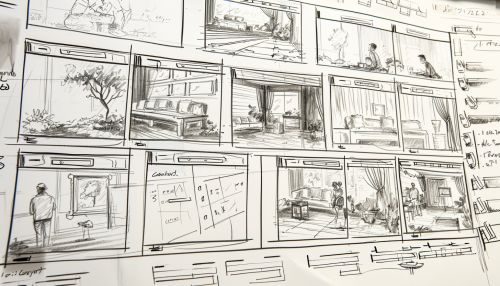Commercial Storyboards
Introduction
Commercial storyboards are a crucial part of the advertising and film production process. They serve as a visual representation of the narrative, helping to map out the sequence of events, camera angles, and other important aspects of a commercial. The storyboard is often the first tangible product of a creative idea, and it plays a pivotal role in communicating the concept to clients, directors, and production teams.


History
The concept of storyboarding originated in the animation industry, with the Walt Disney Company often credited for its popularization in the 1930s. The technique was initially used to pre-visualize animated films, but it soon found its way into live-action film production and eventually, commercial advertising.
Purpose and Benefits
Commercial storyboards serve multiple purposes. They provide a visual representation of the commercial's narrative, allowing the creative team to evaluate and refine the concept before production begins. They also serve as a communication tool, helping to ensure that everyone involved in the production has a clear understanding of the vision for the commercial.
The benefits of using a storyboard in commercial production are numerous. They can save time and money by identifying potential issues early in the process, allowing for adjustments to be made before filming begins. They also facilitate collaboration and communication among the creative team, the client, and the production crew.
Creation Process
The process of creating a commercial storyboard typically begins with a script or a creative brief. The storyboard artist then translates this written document into a series of images, capturing the key scenes and actions.
The artist may use a variety of techniques to create the storyboard, including hand-drawing, digital illustration, or even photography. The level of detail in the storyboard can vary, from simple sketches to highly detailed and colored illustrations.
The storyboard is usually accompanied by notes or descriptions, providing additional information about the scenes, such as camera angles, lighting, and actor movements.
Role in Pre-production
In the pre-production phase of a commercial, the storyboard serves as a guide for planning and organizing the shoot. It helps the director and the production team to visualize the sequence of events, determine the necessary props and locations, and plan the camera angles and movements.
The storyboard also plays a crucial role in budgeting and scheduling. By providing a clear picture of the commercial's requirements, it allows the production team to estimate the cost and time needed for each scene.
Role in Production
During the production phase, the storyboard continues to serve as a reference for the director and the crew. It helps to ensure that all the planned shots are captured and that the narrative flows as intended.
While the storyboard provides a detailed plan for the commercial, it is not uncommon for changes to be made during production. These changes can be due to unforeseen issues, creative decisions, or feedback from the client.
Role in Post-production
In post-production, the storyboard is used as a guide for editing the footage. It helps the editor to assemble the shots in the correct sequence and to achieve the desired pacing and rhythm.
The storyboard can also be used to plan and create any necessary visual effects, animations, or other post-production elements.
Types of Commercial Storyboards
There are several types of commercial storyboards, each with its own purpose and level of detail.
- Concept Storyboards: These are often used in the early stages of the creative process to explore and communicate the initial idea for the commercial. They are typically less detailed and more abstract than other types of storyboards.
- Presentation Storyboards: These are created to present the commercial idea to the client or other stakeholders. They are usually more detailed and polished than concept storyboards, with a focus on conveying the look and feel of the final commercial.
- Shooting Storyboards: These are used during production to guide the filming process. They are highly detailed, including information about camera angles, movements, and other technical aspects.
- Animatic Storyboards: These are a sequence of storyboard images that are edited together with a soundtrack to create a rough version of the commercial. They are used to test the timing and pacing of the commercial before filming begins.
Conclusion
Commercial storyboards are an essential tool in the creation of effective and engaging advertisements. They provide a visual blueprint for the commercial, facilitating communication, planning, and execution throughout the production process. While the creation of a storyboard requires time and resources, the benefits it offers in terms of efficiency, collaboration, and creative clarity make it a worthwhile investment.
See Also
- Storyboard Artist - Advertising Campaign - Film Production Process
